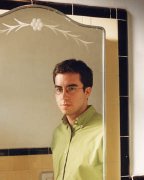March 03, 2005
'BOOKS MAKE PEOPLE LESS ALONE.'

But an article in the New York Times Magazine has me curious about a young author named Jonathan Safran Foer.
The story got my attention. The photo of him passed out as a child sunk the hook. It clearly was taken by a parent who saw in him early the potential for eccentricity.
Here's an excerpt from the profile:
Foer is given to comic self-invention, to feats of distortion and parody -- some of which are dauntingly literary. He was all of 25 when he emerged out of nowhere, in 2002, with his widely acclaimed first novel, ''Everything Is Illuminated.'' Begun while he was still an undergraduate at Princeton, it tells the story of a young, self-deprecating writer named Jonathan Safran Foer who travels to a vanished shtetl in Ukraine, searching for a woman he believed saved his grandfather from the Nazis. The book has sold more than 100,000 copies in hardcover and another 150,000 in paperback, making it that rare event in the publishing industry, a literary best seller, and proving that a difficult, cerebral novel is not doomed to sell 23 copies, all of them to the author's mother. A film version of the novel, directed by Liev Schreiber, is scheduled to be released in August.Foer's second novel, ''Extremely Loud and Incredibly Close,'' will be published in about a month. It shifts his landscape from the wounded earth of Eastern Europe to a fresher site of devastation. The book's main narrator is Oskar Schell, a 9-year-old schoolboy whose father was killed in the attack on the World Trade Center. An aspiring inventor, Oskar consoles himself by thinking up far-fetched creations that could protect people from all sorts of injury. In the process, he becomes a kind of artist, someone whose dreams are so romantic that they are destined to failure. Oskar's creativity is echoed in the design of the novel, a highly experimental affair that draws upon photographs and typographical play in an attempt to blur the old boundaries between image and text. ''It's the kind of book that will look great next to the toilet,'' Foer said jokingly, in response to a compliment about the novel's appearance.
His office occupies a small rented room within walking distance of his home. The place is furnished sparsely, with little besides a long work table, a set of Ikea bookshelves and an oversize canvas dog bed reserved for a female creature named George, apparently a Great Dane mix. A curious object -- a carpenter's hacksaw -- hangs on an otherwise blank wall above the desk. (''You never know when you'll have a bad day,'' Foer explained.) Opposite the door, there is a lovely ink drawing circa 1940, an original self-portrait by Isaac Bashevis Singer, his eyes glinting beneath his pronounced cranium. ''You shouldn't make too much of that,'' Foer told me, not quite convincingly. '''Gimpel the Fool' is probably my favorite short story, but I don't feel any real affinity with Singer. His morality is so 19th century.''
Oddly enough, the room lacks a telephone, a detail that might lead you to envisage the author hunkered down in silent, undisturbed concentration. But the image is a total sham. Foer, as I later learned, didn't compose his new novel in this office, or in any office at all. A kind of poet-wanderer, he does his writing all over town: in public libraries, in coffee shops and even in the homes of friends. The process of writing has traditionally been romanticized by its creators as an act of self-imposed isolation, but Foer redefines it as something more open and oxygenated, an expansive social activity best undertaken amid the clamor of life. Of course, all of this prompts the question of why he needs an office in the first place. ''I need an office,'' he explained, a bit enigmatically, ''so I can have a place where I don't write.''
If you're interested, you can hear Foer read from his new book, "Extremely Loud and Incredibly Close."
Posted by Jeff at March 3, 2005 08:05 AM